SPINNING (from spin, from AS., Goth., OHG. spinnan, Ger. spinnen, to spin; probably connected with AS., OHG. spannan, Ger. spannen, Eng. span, to stretch out, extend, and ultimately with Lat. spatium, extent, Gk. σπᾶν, span, to draw out). The art of drawing, twisting, and combining either animal or vegetable fibres, so that they are formed into continuous threads ready for the further operations of weaving, knitting, or sewing. The principal textile fibres are silk, wool, flax, jute, and cotton (qq.v.), and the method of spinning each of these substances differs slightly from the rest.
The most ancient instruments for spinning were the spindle and distaff, representations of which are to be seen on the earliest Egyptian monuments. The distaff was a stick or staff upon which a bundle of the prepared material was loosely bound, and which was held in the left hand or stuck in the belt; the spindle was a smaller tapering piece to which the thread was attached. By a dexterous twirl of the hand the spindle was made to spin round and at the same time recede from the spinster, who drew out between the forefinger and thumb of the right hand a regular stream of fibres so long as the twisting of the spindle lasted. It was then drawn in, the new length of thread wound upon it, and the operation renewed. An obvious improvement in this device was to set the spindle in a frame and make it revolve by a band passing over a wheel, driven by occasional impetus from the hand.
The Saxon wheel is said to have been invented in Nuremberg in 1530. This wheel, used only for flax-spinning, contained the germ of Arkwright's invention, described later on. A bobbin or ‘pirn’ with a separate motion was placed on the spindle, which had a bent arm — a flyer or flight — for winding the yarn on the bobbin. The spindle and bobbin revolved at different speeds, the revolutions of the spindle giving the twist, and the difference of the speed causing the winding on. The two-handed wheel had two spindles and pirns a little apart, with the distaff stuck into the frame between them, and the spinster produced a thread with each hand.
During the last half of the eighteenth century three inventions were made which completely revolutionized the art of spinning. These three inventions were Hargreaves's spinning jenny, Arkwright's throstle machine or roll-drawing spinning machine, and Crompton's mule spinner.
In the spinning jenny a number of large reels of fibre formed into a thickish coil, called a roving, were set on upright fixed spindles, and the ends of the rovings were passed between two small movable bars of wood placed horizontally and under the control of the spinner, who could thus make them press more or less on the roving, and consequently increase or decrease the draw upon it from the spinning spindles, which were set in a row at the other end of the frame, and all capable of being set in motion simultaneously by the wheel. The spinner drew out the rovings by moving the bars back and forth and at the same time turned the crank with his right hand to rotate the spindles.
The throstle machine, patented by Arkwright in 1769, had for its object the drawing of the rovings through a succession of pairs of rollers, each pair in advance of the others, and moving at different rates of speed. The first pair receive the sliver, compress it, and pass it on to the second pair, which revolve at a greater speed, and thus pull it out to exactly the number of times greater length that their revolutions exceed those of the other pair, and as the first roving is passed though a second, third, and sometimes fourth machine, the finished roving is 32 times longer than the sliver. As the roving issues through the last rollers of each machine it is received on spools or reels, calculated to hold a given quantity; and these are transferred to the spinning frames, which resemble the roving frames. Here the roving takes the place of the sliver, and, as it unwinds from the spool, is drawn through suc- cessive pairs of rollers, moving as before at differ- ent rates, each succeeding pair faster than the backward ones, so that the roving gets thinner and thinner, until the tenuity is carried as far as desirable. It is then carried on to a spindle which revolves with great rapidity, and, by means of a simple arrangement, is made both to twist the thread and wind it on the spindle ready for the weaver.
It was found that the process of spinning by rollers produced too great a strain upon the thread in its progress to admit of its being drawn as fine as is wanted for many purposes, and this led to the invention of the mule jenny by Crompton in 1779, which has a traveling frame upon which the spindles are set, and which in its modern form is described below.
During the nineteenth century many important improvements were made in the details of the construction of spinning machinery, but the general principles are those worked out a hundred years ago. The greatest improvements have been changes in the construction of spindles, allowing them to revolve more rapidly and freely. In the modern factory spinning is the final process in a series of operations necessary to convert the raw fibre into thread. Each of these processes has for its object the removal of smaller and smaller impurities and the production of a finer and stronger thread. These are: (1) opening and picking; (2) carding and combing; (3) drawing; (4) roving; (5) spinning. Other intermediate operations may be introduced.
The opener or breaker lapper is a similar machine to the intermediate or finisher lappers, as shown in Fig. 1, and described below. In the breaker lapper the cotton as taken from the bale is fed to it in a hopper or by some kind of automatic feed, and delivered in laps which are then placed on the intermediate lapper, either 3 or 4 laps being ‘doubled’ on the same and the cotton after being loosened and further cleaned is delivered in laps to be placed on the finisher lapper, 3 or 4 laps from the intermediate being again ‘doubled’ and delivered in a single lap ready for the card. The function of the lappers is to thoroughly loosen the lumps of cotton as taken from the bale, to remove dirt and dust and as much leaf, trash, and motes as possible. There are usually three of these, the breaker, intermediate, and finisher lapper. Fig. 1 is a section of an intermediate or finisher lapper. The cotton enters these machines in a sheet made up from the laps, A, delivered onto the slowly moving apron, from which it is taken by the feed-rolls and delivered to the rapidly revolving beater, which forces it against the grid-bars, loosening the dirt and motes which fall through the grids into the mote-box. The cotton is left in a light and feathery mass which is drawn between the squeeze-rolls by the suction of the fan, which also draws the dust and fine dirt from the beaten mass and discharges them through the dust-flue. The sheet of cotton from the squeeze-rolls is taken by the calender-rolls, and compressed and finally rolled into the lap B. The lap is about one inch in thickness, 40 inches to 48 inches wide, and usually from 48 to 52 yards long.
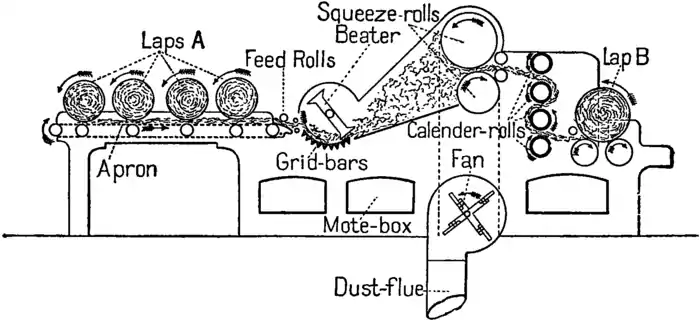
Fig. 1. SECTION OF INTERMEDIATE OR FINISHER LAPPER.
After the cotton has passed through the series
of lappers the laps from the finisher lapper go
to the card (Fig. 2). (See Carding.) The
cotton in the lap A is delivered to the feed-roll
of the card and is grasped by the teeth
of the licker-in or taker-in, from which it is
taken in a thin sheet by the fine wire teeth of
the card-clothing on the cylinder B, and carried
upward to come in contact with the teeth on the
clothing of the top-flats, and the fibres are
combed into a degree of parallelism — the cylinder
revolving rapidly, while the flats, which are in a
chain, move slowly forward so that new flats are
continually coming in contact with the cylinder —
and much of the short and broken fibres is
removed: the comb, C, removes the short fibres
from the flats and they are rolled upon the rod,
and the flats are further cleaned by the brush.
The carded cotton is taken from the cylinder by
the doffer cylinder, the latter having a surface
velocity somewhat less than that of the main
cylinder, and is removed from the doffer by the
comb, D, in a thin evenly carded film; this film
is drawn through the trumpet by the calendar-rolls,
in a round strand about one inch thick
called a sliver, which is automatically coiled in
the sliver-can by the coiler.
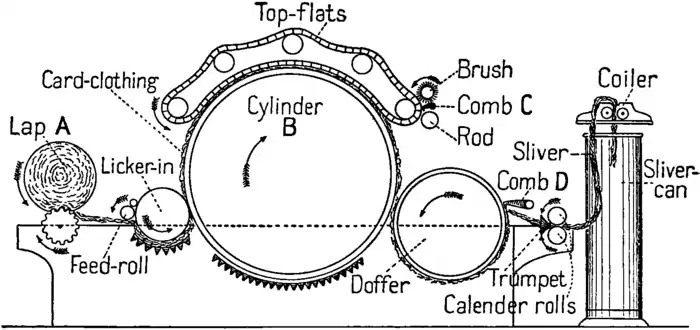
Fig. 2. SECTION OF REVOLVING TOP-FLAT CARD.
As all the processes are arranged to ‘double’
the mass of cotton and then to reduce the mass
in size by ‘drawing’ it out to several times its
original length until the yarn is finally produced,
an examination of Fig. 3 will help the reader to
understand how the ‘drawing’ acts on the fibres.
On the left is shown the sliver from the card, the
cotton being in a more or less tangled condition,
but after passing between the successive pairs of
drawing-rolls, 4.4', the last or right hand pair,
revolving faster than the others, ‘draws’ the
fibres past each other and straightens them,
bringing them into a nearly parallel position.
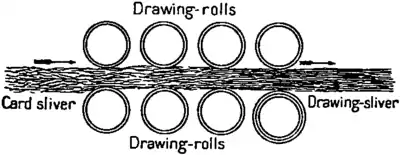
Fig. 3. DETAIL OF DRAWING PRINCIPLE.
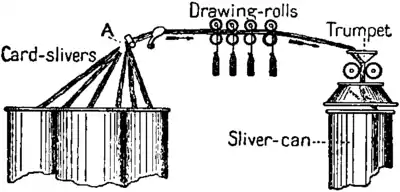
Fig. 4. SECTION OF DRAWING FRAME.
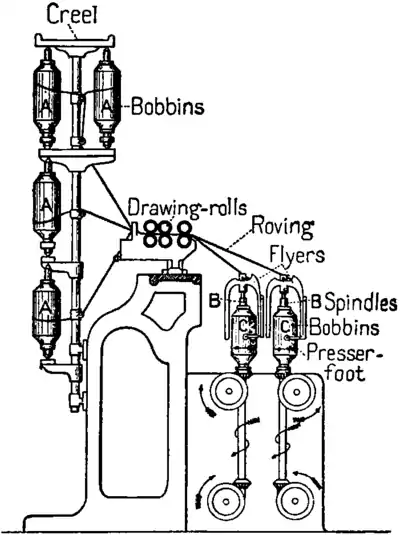
Fig. 5. SECTION OF ROVING FRAME.
The card-sliver goes first to the drawing frame.
Fig. 4, and four or six slivers, A, are combined by
passing them through the drawing rolls as above
described. The drawing sliver is carried through
the trumpet and deposited in the can by the coiler
the same as from the card. This drawing process is
repeated two or three times as the work may
demand, always ‘doubling’ and ‘drawing,’ but without
putting in any twist. After the drawing
frames, the drawn sliver is placed in cans, behind
the first of the roving frames which have rolls
similar to the drawing frames, but have spindles
by which the stock, then called roving, is twisted
and wound on bobbins. The first of the roving
frames is called the slubber, and is heavier than
the intermediates and fine frames, as the other
roving frames are designated. The full bobbins,
A, from the slubber are placed in the creel of the
intermediate frame, as shown in Fig. 5, and two
strands combined are delivered to the rolls and
drawn, the new strand of roving is carried to the
top of the flyer, on the spindle B, is passed
through one arm of the fiyer, which is hollow, and
delivered to the bobbin, C, by the presser-foot.
The revolving of the flyer puts the twist into the
strand of roving, while the difference in speed
between the flyer and the surface of the bobbin
winds the roving on the latter.
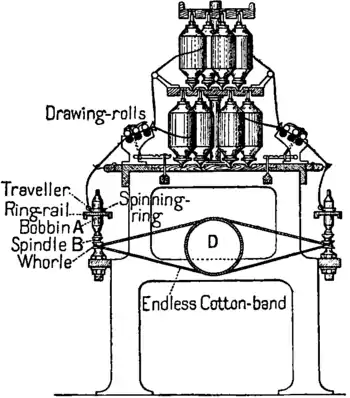
Fig. 6. SECTION OF SPINNING FRAME.
The fine frame is a similar frame to the above,
and delivers the roving finer and more even than
any of the preceding machines and ready for
the spinning frame (Fig. 6). The roving may be
doubled or run singly on the spinning frame, the
rolls produce the drawing effect as on the
preceding machines, and the revolution of bobbin
and spindle puts in the twist. The bobbin A is
fast on the spindle B, and draws the yarn
through the traveler, a small wire loop attached
to and movable on the spinning ring, which
surrounds each spindle. The spindles are made to
revolve by an endless cotton band, which passes
around the whorl of the spindle and is driven by
the cylinder D. The production of the spinning
frame is technically ‘frame-spun yarn,’ either
warp or filling. This is wound on the bobbins
by the moving up and down of the ring rail,
which holds the spinning rings with the travelers,
the pull or drag of the travelers winding the
yarn on the bobbin.
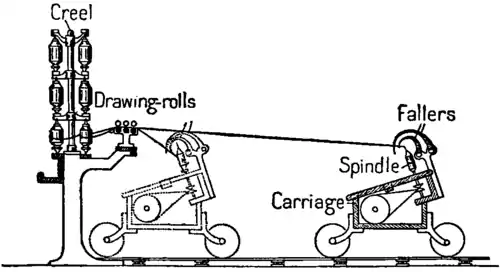
Fig. 7. SECTION OF SPINNING MULE.
Mule-spun yarn is produced by spinning the
roving on a mule (Fig. 7), the roving coming
from the fine frames as for frame-spun yarns,
but the drawing and twisting being accomplished
in a different manner. On the spinning frame
the roving is drawn, twisted, and wound
continuously, while on the mule it is drawn out
while the twist is being put in and is spun
intermittently, and then wound on bobbins or cops
intermittently. The roving is placed in a creel and
passed through the drawing rolls, as on the spinning
frame, and carried to the spindles, which,
instead of being in a stationary rail, are mounted
in a carriage, which runs away from and back
to the rolls alternately, traveling about 5 feet
each way. As fast as the rolls deliver the roving
the carriage and spindles recede from the roll
stand and the spindles revolving twist tHe yarn
over the top of the spindles, where it is held by
the fallers. In some cases the carriage travels
several inches more than the delivery of the
front roll and causes additional drawing. The
movement out of the carriage is called stretch,
and at the end of each stretch the rolls are
stopped automatically, the required twist being
completed, the spindles are stopped and reversed
in motion, while the fallers guide the spun yarn
away from the top of the spindle and wind it on
the cop or bobbin, the carriage approaching the
rolls again, after which the same movements are
repeated continuously. The spinning frames are
arranged with an average of 104 spindles to a
side of about 27 feet in length, but this number
varies according to the gauge or distance
between centres of spindles. The mules, not having
spinning rings, admit of the spindles being
nearly twice as near together, the average number
per mule being 480, though some are built
much larger.
In a general way the spinning of other textile fibres is the same as for cotton, the desire being to reduce the strands and to make them of uniform diameter throughout their entire length and to give them the requisite amount of twist. Woolen yarn is spun on a mule as described for spinning cotton, except that the carded roving comes to the mule in a different shape, being carded differently and without twist until spun on the mule. Worsted and some cotton yarns are produced by a combing operation which is a special drawing process, the cotton being afterwards worked on the roving frames, while worsted is spun on a frame not unlike the roving frame, the twist being put in by flyers, as the twist in the cotton roving. For the spinning of silk and other fibres, see special articles on those fibres.
Bibliography. Consult: Posselt, Structure of Fibres, Yarns, and Fabrics (Philadelphia, 1890); Byrn, Progress of Invention in the Nineteenth Century (New York, 1900); and the preliminary chapter in Ashenhurst, Weaving and Designing of Textile Fabrics (Bradford, Eng., 1887). More technical in treatment are the two books by Thomas Thornley, Draw Frames and Fly Frames, and Self-Acting Mules (London, 1898). See Loom; Weaving; Textile Manufacturing.